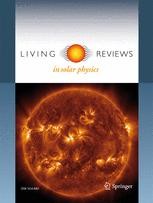Living Reviews in Solar Physics: "Space weather: the solar perspective"
 Temmer, M. Space weather: the solar perspective. Living Rev Sol Phys 18, 4 (2021). https://doi.org/10.1007/s41116-021-00030-3
Temmer, M. Space weather: the solar perspective. Living Rev Sol Phys 18, 4 (2021). https://doi.org/10.1007/s41116-021-00030-3
Open Access | Review Article
Published: 29 June 2021
An update to Schwenn (2006)
Abstract:
The Sun, as an active star, is the driver of energetic phenomena that structure interplanetary space and affect planetary atmospheres. The effects of Space Weather on Earth and the solar system is of increasing importance as human spaceflight is preparing for lunar and Mars missions. This review is focusing on the solar perspective of the Space Weather relevant phenomena, coronal mass ejections (CMEs), flares, solar energetic particles (SEPs), and solar wind stream interaction regions (SIR). With the advent of the STEREO mission (launched in 2006), literally, new perspectives were provided that enabled for the first time to study coronal structures and the evolution of activity phenomena in three dimensions. New imaging capabilities, covering the entire Sun-Earth distance range, allowed to seamlessly connect CMEs and their interplanetary counterparts measured in-situ (so called ICMEs). This vastly increased our knowledge and understanding of the dynamics of interplanetary space due to solar activity and fostered the development of Space Weather forecasting models. Moreover, we are facing challenging times gathering new data from two extraordinary missions, NASA’s Parker Solar Probe (launched in 2018) and ESA’s Solar Orbiter (launched in 2020), that will in the near future provide more detailed insight into the solar wind evolution and image CMEs from view points never approached before. The current review builds upon the Living Reviews article by Schwenn from 2006, updating on the Space Weather relevant CME-flare-SEP phenomena from the solar perspective, as observed from multiple viewpoints and their concomitant solar surface signatures.
The author:
Manuela Temmer is Associate Professor at the University of Graz, where she leads the Heliospheric Physics Research Group.
Her research focus lies in solar and heliospheric physics, with application to the impact of solar activity on Earth as well as human and robotic explorers across the solar system (Space Weather). She works toward understanding the physics behind the dynamic processes and interrelations between flares, coronal mass ejections, and solar wind structures in interplanetary space. Besides working in an interdisciplinary field across several physics domains, of current major interest is the validation and improvement of state-of-the-art Space Weather models by using remote sensing image data and in-situ measurements from multiple viewpoints.
